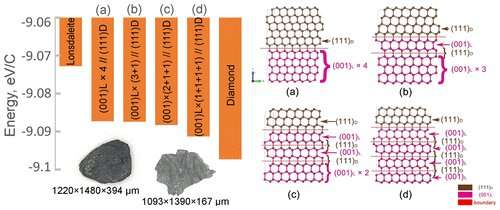Physicists have revealed new properties of Yakutia diamonds

TSU physicists, working with scientists from Novosibirsk, Krasnoyarsk, Germany and Korea, have discovered new nanomechanical properties of diamonds mined at the Skalnoe deposit of the Popigai astrobleme. Using a combination of experimental and theoretical methods, they proved that this kind of mineral is able to resist all-round compression more strongly than "ideal" specimens. The diamonds of the Popigai crater are used as optical materials in laser systems, so the task of physicists was to compare their properties to the existing analogs.
The Popigai astrobleme is a meteorite crater located in Siberia in the basin of the Popigai River. Its diameter is about 100 km, and it is the fourth-largest crater in the world. The Popigai astrobleme was formed about 35 million years ago during the impact of a giant meteorite on a rocky ridge and was discovered in 1946. Later, it was established that the Skalnoe deposit alone contains more diamonds than all the kimberlite deposits in the world. Now, these diamonds are used, among other things, as optical materials in laser systems.
As part of the project, scientists studied the structure and mechanical properties of unique impact diamonds, that is, diamonds formed as a result of geological processes that began after the impact of a meteorite.
Physicists investigated biphasic diamonds containing hexagonal and cubic phases (the phase indicates how the chemical element of the diamond—the carbon atom—is organized). The structure and mechanical properties of Popigai impact varieties were investigated by high-pressure X-ray diffraction (up to 25 GPa). In the course of experimental work, scientists for the first time were able to obtain the bulk modulus (the ability of a substance to resist all-round compression) for the hexagonal diamond phase.
"Theoretical calculations performed at TSU using the electron density functional method showed another result: Popigai diamonds have a higher bulk modulus than the ideal diamonds for the cubic and hexagonal phases," said Pavel Avramov, the leading member of the Laboratory of Photophysics and Photochemistry of Molecules of the TSU Faculty of Physics. The results expand the scope of the diamonds found, for example, in scientific experiments in quantum physics, optics, laser technologies and space research, fields in which errors are unacceptable.
The article "Unique Nanomechanical Properties of Diamond–Lonsdaleite Biphases: Combined Experimental and Theoretical Consideration of Popigai Impact Diamonds" was published in Nano Letters.
More information: Woohyeon Baek et al. Unique Nanomechanical Properties of Diamond–Lonsdaleite Biphases: Combined Experimental and Theoretical Consideration of Popigai Impact Diamonds, Nano Letters (2019). DOI: 10.1021/acs.nanolett.8b04421
Journal information: Nano Letters
Provided by Tomsk State University



















